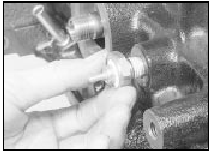Engine dismantling, examination, renovation and reassembly - general information
1.8 litre (R2A type)
Dismantling
1 It is best to mount the engine on a
dismantling stand, but if this is not available,
stand the engine on a strong bench at a
comfortable working height. Failing this, it will
have to stripped down on the floor.
2 Cleanliness is most important, and if the engine is dirty, it should be cleaned with paraffin while keeping it in an upright position.
3 Avoid working with the engine directly on a concrete floor, as grit presents a real source of trouble.
4 As parts are removed, clean them in a paraffin bath. However, do not immerse parts with internal oilways in paraffin as it is difficult to remove, usually requiring a high pressure hose. Clean oilways with nylon pipe cleaners.
5 It is advisable to have suitable containers available to hold small items according to their use, as this will help when reassembling the engine and also prevent possible losses.
6 Always obtain a complete set of new gaskets for use during engine reassembly, but retain the old gaskets with a view to using them as a pattern to make a replacement if a new one is not available.
7 Where possible, refit securing nuts, bolts and washers to their locations after removing the relevant components. This will help to protect the threads and will also prevent possible losses.
8 Retain unserviceable components in order to compare them with the new components supplied.
9 A suitable Torx socket will be required to remove the oil pump cover securing screws.
10 Before dismantling the main engine
components, the following externally mounted
ancillary components can be removed:
Inlet manifold and carburettor
Exhaust manifold
Fuel pump and operating pushrod
Alternator
Spark plugs
Oil pressure warning lamp switch (see
illustration)

17.10 Removing the oil pressure warning lamp switch - 1.8 litre (R2A)
Oil filter
Dipstick
Engine mounting brackets
Clutch
Alternator mounting bracket
Crankshaft speed/position sensor
Engine lifting brackets
Examination and renovation
11 Refer to Section 18 in Chapter 2, Part A.
Reassembly
12 To ensure maximum life with minimum
trouble from a rebuilt engine, not only must
everything be correctly assembled, but it must
also be spotlessly clean. All oilways must be
clear, and locking washers and spring
washers must be fitted where indicated. Oil all
bearings and other working surfaces
thoroughly with engine oil during assembly.
13 Before assembly begins, renew any bolts or studs with damaged threads.
14 Gather together a torque wrench, oil can, clean rag, and a set of engine gaskets and oil seals, together with a new oil filter.
15 If they have been removed, new cylinder head bolts, big-end bolts/nuts and new flywheel bolts will be required.
16 After reassembling the main engine components, refer to paragraph 10 and refit the ancillary components listed. Delicate items such as the alternator may be left until after the engine has been refitted.
1.6 and 1.8 litre (R6A type)
Dismantling
17 Refer to paragraphs 1 to 9 inclusive.
18 Before dismantling the main engine components, the following ancillary components can be removed: Inlet manifold and CFI unit.
Exhaust manifold .
Alternator.
Spark plugs and HT leads.
Ignition coil and mounting bracket.
Oil pressure warning lamp switch.
Oil filter.
Dipstick and tube.
Engine mounting brackets.
Clutch.
Alternator mounting bracket.
Crankshaft speed/position sensor.
Engine lifting brackets.
Crankcase ventilation hose.
Examination and renovation 19 Refer to Section 18 in Chapter 2, Part A.
Reassembly
20 Refer to paragraphs 12 to 16 but note that
new rocker arm nuts will be required, if they
have been removed.
See also:
Sump - removal and refitting
Note: New gaskets and sealing strips will be
required for refitting, and sealing compound
will be required to coat the gasket faces.
Removal
1 If the engine is in the vehicle, proceed as
follows, ...
Braking system warning lamps and electrical switches - removal
and refitting
General
1 All models are fitted with a low fluid level
warning switch in the master cylinder reservoir
cap and a brake pedal stop-lamp switch.
2 Some versions have front disc pad wear
sensors and ...
Rear suspension lower arm (Saloon and Estate models) - removal
and refitting
Removal
1 Raise the rear of the car and support it on
stands (see “Jacking and Vehicle Support”).
2 On cars equipped with the anti-lock braking
system, refer to Chapter 9 and remove the
load appo ...
